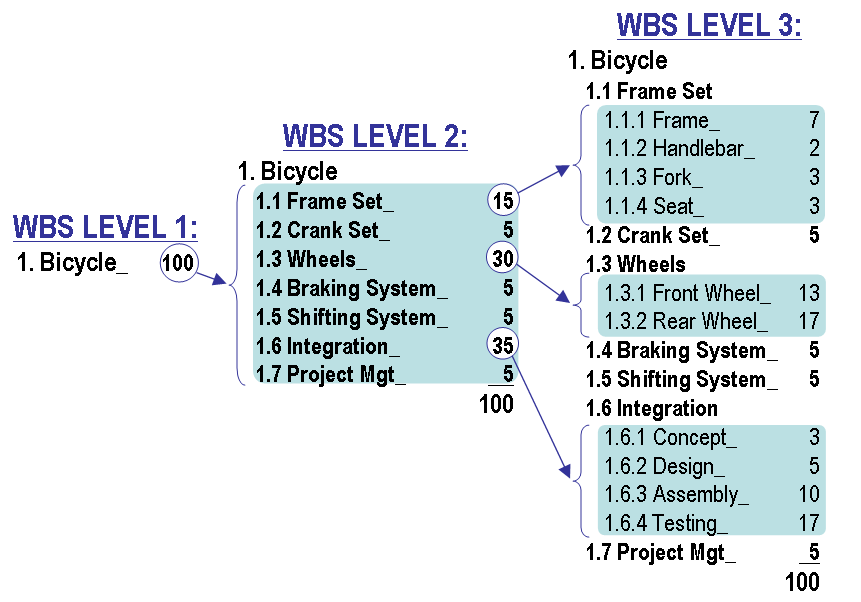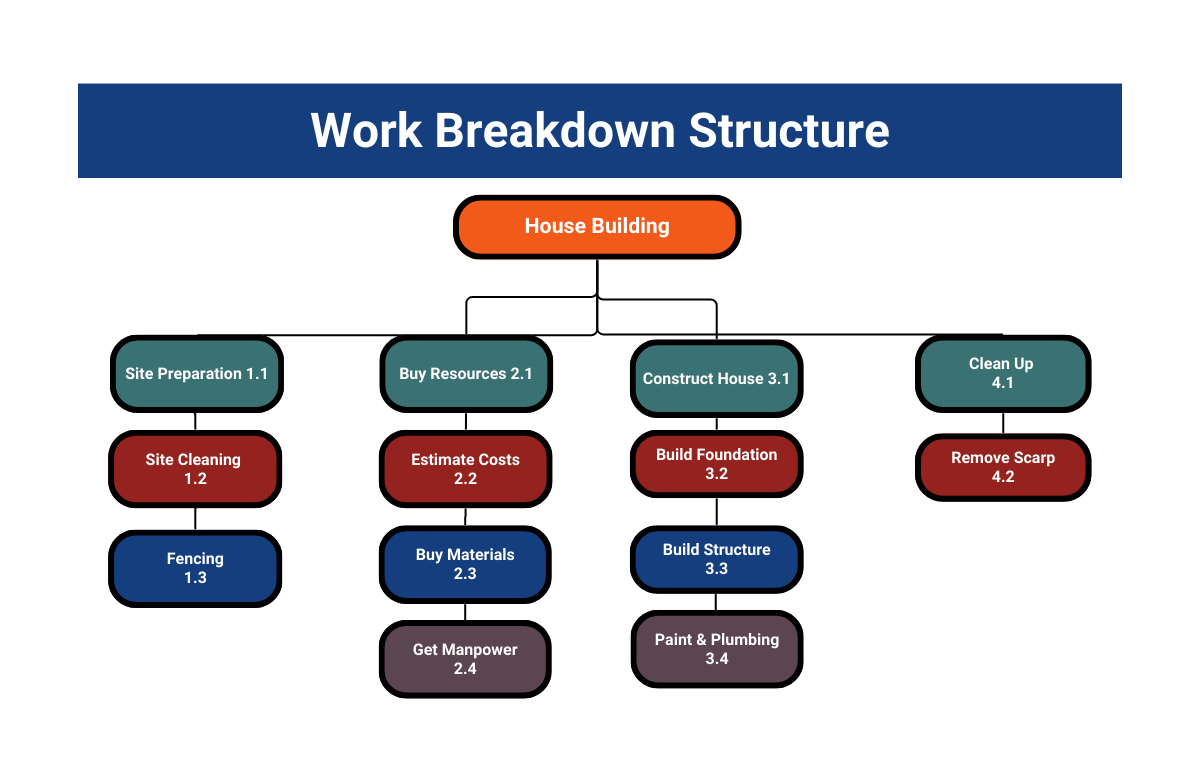Defining your project’s scope in precise, actionable steps is critical for controlling execution within budget and schedule. The WBS Dictionary provides this granular detail on the tasks, deliverables, milestones, and activities needed to meet objectives.
Supplementing your high-level Work Breakdown Structure (WBS) with this vital document establishes your project scope baseline and empowers you to execute your project according to plan for success.
Learn best practices for leveraging your WBS Dictionary to enable effective communication of scope, prevent scope creep, and aid monitoring and control.
What is a WBS Dictionary?
The WBS Dictionary is a document that provides detailed information on each component in the Work Breakdown Structure (WBS). The WBS is high-level and doesn’t explain the scope of work or provide details on the tasks or work packages.
This is where the WBS dictionary comes in to complement the WBS by expanding on the high-level WBS by defining the specific deliverables, activities, milestones, and other elements needed to deliver the project.
As a project manager, the WBS Dictionary is essential for your project scope management efforts. Along with the WBS and project scope statement, it establishes the project scope baseline that allows you to measure performance throughout execution.
The WBS Dictionary enables clear communication of the project scope to stakeholders and also helps prevent scope creep by delineating precise deliverables and tasks.
Referring to this vital document will help you maintain control as you direct the work necessary to successfully complete the project according to plan.
What is the Importance of WBS Dictionary?
The WBS Dictionary serves several critical functions:
- Provides Centralized Reference: The WBS Dictionary serves as a centralized reference document detailing project scope and plans for execution.
- Enables Task Ownership and Accountability: The WBS Dictionary creates transparency on who is accountable for completing specific tasks and work packages by assigning owners.
- Supports Accurate Estimating: The WBS Dictionary allows for estimating costs, resources, and time requirements at a granular level for each component.
- Facilitates Realistic Scheduling: With detailed task information, the WBS Dictionary enables the development of realistic and accurate project schedules.
- Identifies Task-Level Risks: Specific assumptions and risks associated with work packages can be identified in the WBS Dictionary.
- Clarifies Handoffs: The WBS Dictionary facilitates clear handoffs between project phases by detailing transition requirements.
- Provides Earned Value Baseline: The WBS Dictionary gives the baseline for earned value management to monitor and control performance.
- Improves Stakeholder Communications: Communication and coordination between the project team, sponsors, and stakeholders is enhanced by the WBS Dictionary.
- Aligns Team on Details: The WBS Dictionary aligns the entire team on project objectives, deliverables, standards, and requirements.
- Reduces Ambiguities: By reducing ambiguities in work definitions, the WBS Dictionary helps minimize change requests and scope creep.
- Documents Planning Decisions: The WBS Dictionary serves as an audit trail, documenting project planning analysis and decisions.

Who Creates the WBS Dictionary?
The project manager should take responsibility for developing the initial draft of the WBS Dictionary. As a project manager, you should leverage your expertise to establish a standard structure and baseline content.
However, creating an accurate dictionary requires input from others in the team. Engage subject matter experts on the project team to contribute details relevant to their roles and responsibilities.
Solicit feedback from the project sponsors and key stakeholders as well. Developing the WBS Dictionary should be a collaborative effort, with you driving the process to completion.
The resulting artifact will reflect the shared understanding of the scope required to successfully manage the project.
| S/No | Item | Description |
|---|---|---|
| 1 | Identifier | A unique identifier assigned to each task or element |
| 2 | Assumptions and Constraints | Assumptions and constraints tied to the task |
| 3 | Owner | Team member responsible for the task |
| 4 | Deliverable | What is expected to be delivered when the task is completed |
| 5 | Schedule | Expected timeline of completion |
| 6 | Resource Requirements | Resources needed for the task |
| 7 | Cost Estimate | Estimated costs for completing the task |
| 8 | Quality Standards | Expected quality and acceptance criteria of deliverable |
| 9 | Risks | Risks associated with the task |
| 10 | Procurement Requirements | Any requirements to complete the task that need to be procured |
Components of a WBS Dictionary
The WBS Dictionary provides additional details on each component of the WBS. Though formats can vary, most WBS Dictionaries contain these core elements:
1. Task Identifiers and Descriptions
Each element in the WBS should have a unique identifier and title assigned to it. The WBS Dictionary describes the specific work and deliverables involved in executing each task.
2. Assumptions and Constraints
The WBS Dictionary is where you document relevant assumptions and potential constraints that could impact specific WBS components. These may relate to task sequences, resource needs, budget, or other factors.
3. Owners and Responsibilities
Each task or deliverable in the WBS should have an owner – the individual responsible for completing that element. The WBS Dictionary identifies the task owner and clarifies roles and responsibilities.
4. Milestones and Deliverables
Major milestones, target completion dates, and interim deliverables are identified in the WBS Dictionary. This helps stakeholders understand key deadlines and work products.
5. Schedule Information
The timing for execution of each WBS component is outlined in the WBS Dictionary. This includes projected duration, start/finish dates, predecessors, and dependencies.
6. Resource Requirements
The resources needed to complete each task, including labor, equipment, and materials, are detailed in the WBS Dictionary.
7. Cost Estimates
Rough order of magnitude or detailed cost estimates are provided for each WBS task and deliverable.
8. Quality Standards
Relevant quality standards, acceptance criteria, and quality control activities are noted in the WBS Dictionary.
9. Risks and Mitigations
Key risks identified for specific WBS components are documented, along with mitigation actions.
10. Procurement Requirements
Any procurement requirements related to WBS tasks, such as contracts, are detailed in the dictionary.
How to Create a WBS Dictionary
To create a WBS dictionary, you would typically use a table or spreadsheet making it easy to read and update. Remember, the WBS dictionary should be a living document, updated as needed throughout the project.
Here’s a step-by-step guide to creating a WBS dictionary:
- Identify WBS Components: List all the components from your Work Breakdown Structure.
- Describe the Work: For each component, provide a brief definition or description of the work to be done.
- Identify Responsible Parties: Note down the person or team responsible for each component.
- Estimate Resources: List the resources required, including people, equipment, and materials.
- Estimate Duration: Provide an estimate of how long each task will take to complete.
- List Dependencies: Identify any tasks that depend on the completion of others.
- Identify Deliverables: List the specific outputs or deliverables for each task.
- Assign a Unique Identifier: Each component should have a unique identifier, generally following the numbering used in the WBS.
- Risk Information: Include any potential risks associated with each component.

WBS Dictionary Example Template
This template covers the WBS dictionary structure along with task details, assumptions, constraints, owners, timelines, resources, costs, risks, and quality for each element. The template can be customized and expanded as needed.
Best Practices for Maintaining the WBS Dictionary
Proper WBS Dictionary management ensures it stays relevant as the project progresses:
Store WBS Dictionary with WBS for Easy Reference
Keep the WBS Dictionary in the same document or system as the WBS for easy access. This allows users to reference any element’s extended details in the dictionary while viewing high-level branches in the WBS.
Update for Changes in Scope, Schedule, and Resources
As project realities shift, promptly update the WBS Dictionary to reflect adjustments to scope, schedule, milestones, assigned resources, and other elements.
Review Regularly as Part of Project Oversight
During regular project status meetings and reviews, validate that the WBS Dictionary still aligns accurately with the current plan. Identify any updates needed.
Use Project Management Software to Simplify Updates
Utilize PMIS capabilities to automatically link WBS and WBS Dictionary data. This enables any changes to simultaneously update both artifacts while reducing manual work.
Conduct Regular Audits
Perform periodic audits of the WBS Dictionary to ensure quality, accuracy, and alignment with current baselines. Identify any improvements needed.
Highlight Recent Revisions
Use formatting like highlighting or font color to note recent updates to the WBS Dictionary after changes are made. This draws attention to modified areas.
Integrate Dictionary with Schedule
Link WBS Dictionary task details to the project schedule to provide context and support activity sequencing and constraints.
Circulate for Team Review
Share updated versions of the WBS Dictionary with team members and validate that it matches their understanding. Seek feedback on improvements.
Archive Historical Versions
Save and archive older versions of the WBS Dictionary as you update it over the project lifecycle. This provides records of scope changes.
WBS vs WBS Dictionary
These WBS and WBS Dictionary are two project scope artifacts that work hand-in-hand to establish a baseline for delivering contracted project deliverables within budget and schedule.
The WBS provides a structured visual decomposition of the project scope into manageable work packages and the WBS dictionary serves as a companion supplement, offering more in-depth specifications to understand each element.
While the WBS displays the hierarchy of tasks and subtasks in an outline or tree diagram, the dictionary elaborates on those components with additional attributes like descriptions, owners, timelines, resources, and costs.
In a nutshell, the WBS provides the skeleton while the WBS dictionary provides the supplemental details needed to effectively plan and execute the work. The WBS dictionary operationalizes the high-level WBS framework with actionable, text-based task information.

WBS Dictionary PMP Exam Tips
If you are preparing for your PMP exam, an understanding of the Work Breakdown Structure (WBS) Dictionary is crucial.
According to the PMBOK Guide, the WBS Dictionary is developed during the “Create WBS” process of the Project Scope Management knowledge area.
It accompanies the WBS and provides detailed deliverables, activities, and scheduling information about each component of the WBS.
For the exam, remember that the WBS Dictionary is not just a glossary but an extensive document that includes work package descriptions, assigned resources, milestones, contractual information, and cost estimates.
It’s used throughout the project lifecycle, serving as a reference during Define Activities, Estimate Costs, and Control Scope processes among others.
Tips for mastering WBS Dictionary questions on the PMP exam:
- Understand its role in the scope baseline: The WBS Dictionary, along with the scope statement and WBS itself, comprises the project’s scope baseline.
- Know its contents: Be familiar with what typically goes into a WBS Dictionary—assumptions, constraints, technical references, and the code of accounts identifier.
- Recognize its benefits: It helps in avoiding scope creep, improving communication, and ensuring clarity and understanding among stakeholders.
Conclusion
The WBS Dictionary plays a pivotal role in project scope management by complementing the WBS with detailed task information.
Maintaining this document provides a helpful reference to direct work, enabling you to execute according to plan and control scope. It promotes stakeholder understanding while preventing unwelcome scope creep.
Investing time in a robust WBS Dictionary gives you a foundation to successfully manage your project lifecycle from end to end.
WBS Dictionary FAQs
What is WBS Dictionary Level?
The WBS Dictionary Level refers to the depth of detail provided in the dictionary entries for each component of the WBS structure. The level of detail should be sufficient for stakeholders to understand the key parameters and requirements to complete the work package. The depth will vary but typically aligns with the level of decomposition in the WBS framework
What is the Difference between WBS Dictionary and Activity List?
A WBS Dictionary provides detailed descriptions of the work packages in a Work Breakdown Structure, including resources, deliverables, and responsible parties. An Activity List, however, specifically outlines the tasks needed to complete each work package, serving as a basis for schedule development.
The format of the WBS Dictionary is essentially the same for all projects. True or false?
False. The format of the Work Breakdown Structure (WBS) Dictionary can vary among projects. It is tailored to suit the specific requirements, complexity, and nature of each project. It should include relevant details that aid in project management and execution.





